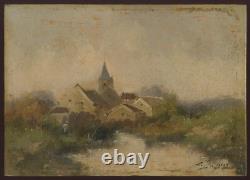
- Home
- Art Movement
- Characteristics
- Boxed (2)
- Framed (21)
- Framed, On Canvas (10)
- Framed, On Panel (2)
- Framed, On Wood (37)
- Framed, Signed (4)
- Miniature (3)
- On Canvas (8)
- On Panel (24)
- On Wood (124)
- On Wood, On Canvas (6)
- On Wood, On Panel (15)
- On Wood, Signed (3)
- Signed (13)
- Signed, On Canvas (12)
- Signed, On Panel (10)
- Signed, On Wood (55)
- Other (4611)
- Genre
- Abstrait (59)
- Académisme (57)
- Art Déco (50)
- Barbizon (27)
- Baroque (86)
- Classicism (74)
- Classicisme (225)
- Expressionism (154)
- Expressionnisme (160)
- Fauvism (34)
- Fauvisme (53)
- Impressionism (177)
- Impressionnisme (497)
- Impressionniste (33)
- Orientalisme (74)
- Orientaliste (26)
- Realism (59)
- Renaissance (27)
- Romantisme (116)
- Réalisme (204)
- Other (2768)
- Style
- 1900 Ou Avant (6)
- 1910-1920 (6)
- 1920-1930 (26)
- 1920-1940 (9)
- 20th Century Style (15)
- Art Deco (6)
- Contemporary (7)
- Non-spécifié (59)
- Not Specified (18)
- Unspecified (50)
- École De Barbizon (12)
- 1900 (12)
- 1920 (9)
- 1930 (16)
- 1930-1940 (17)
- 1940 (26)
- 1940-1960 (236)
- 1970 (46)
- 1980 (22)
- 1990 (11)
- Other (4351)
- Theme
- Abstract (7)
- Animals (27)
- Architecture (7)
- Character (58)
- Child (4)
- Flower, Tree (15)
- Genre Scene (38)
- History, War (5)
- Horse Portrait. (2)
- Hunting, Fishing (5)
- Landscape (299)
- Landscape Riverbank (2)
- Marine (3)
- Marine Landscape (2)
- Nude (2)
- Nude Woman (2)
- Portrait (8)
- Religion, Mythology (22)
- Seascape, Boat (49)
- Still Life (47)
- Other (4356)
- Type
Eugene Galien Laloue Oil on Wood Panel Signed




Original oil painting on wood panel, hand-signed L. Dupuis (pseudonym Léon Dupuis) at the bottom right corner. Condition: see photographs; good; slight defects at panel borders (marks of previous frame). Dimensions: 15.9x22.1 cm.
Free hand delivery possible in Paris by appointment. The artwork is sold with an invoice that includes a detailed description.
Eugène Galien-Laloue, the real name of Eugène Gallien Laloue, is also known by several pseudonyms including Léon Dupuy, Eugène Dupuy, Juliany, Eugène Galiany, Jacques Liévin, Eugène Lemaitre, Maurice Lenoir, Dumoutier, and A. He was born on December 11, 1854, and died on April 18, 1941.
His mother placed him with a notary. Cheating on his age, he enlisted to serve in the military.
In 1874, he lived in [location]. He was recruited by the French railway company to draw the layout of the tracks from Paris to provincial stations; he took the opportunity to paint the surrounding landscapes, producing a considerable number of gouaches while carefully respecting the layout of the tracks. He varied the sky's tone, the appearance of trees, and the lighting according to the seasons, animating the scenes with figures and particularly enjoying the effects of wet sidewalks under rain or snow. His work is also closely related to the village landscapes of the Île-de-France countryside.
In 1874, he stayed in [location] where he painted sunsets and sunrises, as well as scenes of farmyards and courtyards.
In 1892, he married for the second time the sister of his first wife, Ernestine Bardin, who gave him a daughter, Flore Marie Agnès, on February 4, 1893. That same year, he worked at [location] but his solitary nature did not fit with this place.
At the declaration of [event], he was not mobilized due to his voluntary engagement in 1870 and his age, but he made numerous drawings and watercolors of military scenes in 1914.
His daughter left the parental home after her marriage in 1919. Ernestine Bardin died in 1925.
He then married the third sister of his previous wives, Claire Bardin, in 1930. Widowed again in 1933, he moved in with his daughter Flore in 1935. In 1940 he went into exile to [location], unable to paint due to a fractured arm. He painted landscapes of [location].The pictorial output of this artist, under his own name or pseudonym, was prolific, and his commercial success attracted imitators whose pastiches are common in the art market. He had two studios in [location]: one at 4 [street] in 1877 and the second at 24 [street] where he worked in 1886.
In 1906 he settled in [location]. He died on April 18, 1941, at his daughter's country house in [location], and was buried in the municipal cemetery.

